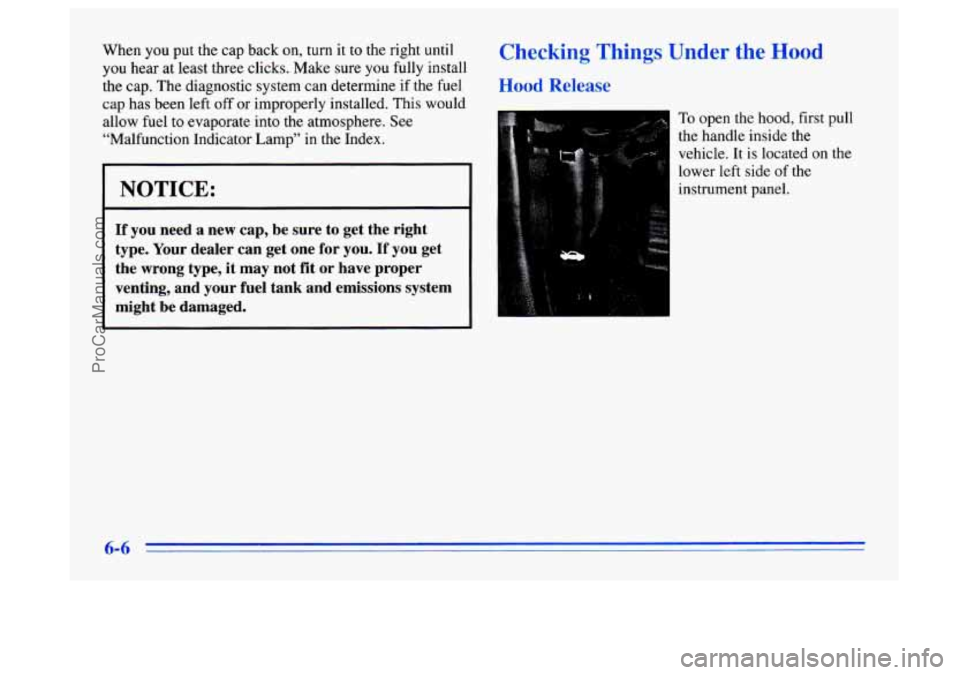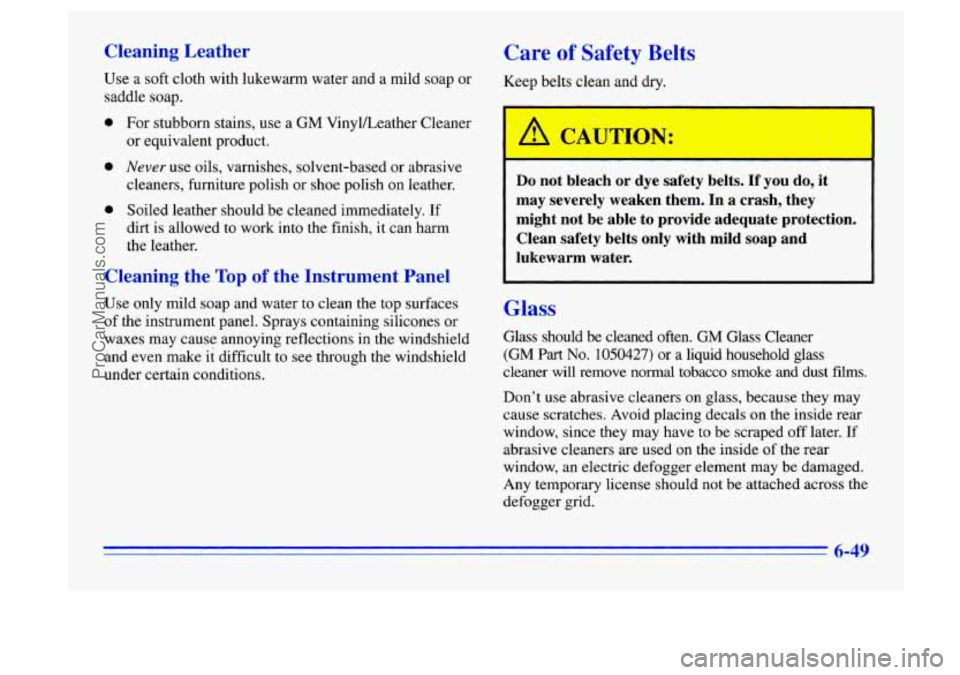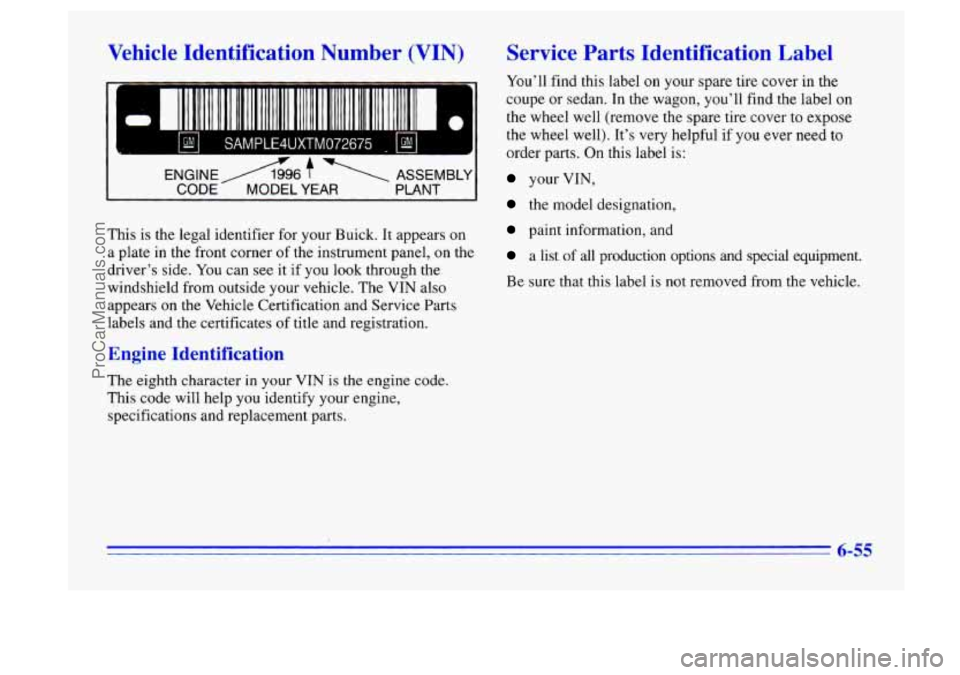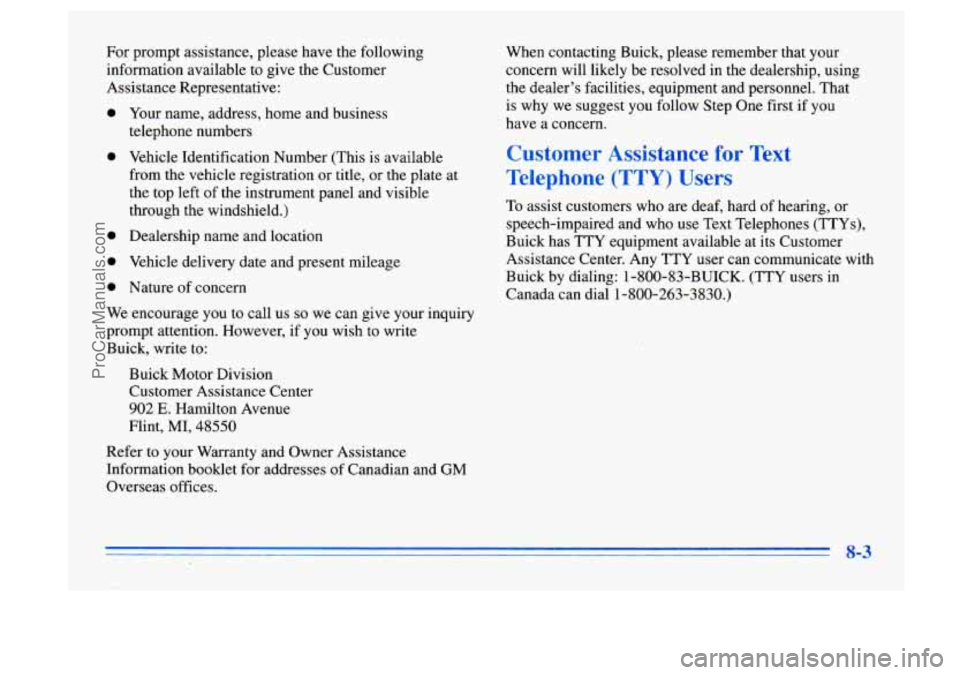1996 BUICK CENTURY instrument panel
[x] Cancel search: instrument panelPage 121 of 340

Rear Window Defogger
REAR
!
The rear window defogger
uses
a warming grid to
remove fog from the rear
window. In winter, it can
also keep ice from forming
on the rear window.
Press the
ON portion of the switch. The indicator light
will glow. The rear window defogger
will turn off
automatically after about 10 minutes of use. You can
also
turn it off by turning off the ignition or pressing the
OFF portion of the switch.
I NOTICE:
Don’t use a razor blade or something else sharp
on the inside
of the rear window. If you do, you
could cut or damage the warming grid, and the
repairs wouldn’t be covered by your warranty.
Ventilation System
Your Buick’s flow-through ventilation system supplies
outside air into the vehicle when
it is moving. Outside
air
will also enter the vehicle when the heater or the air
conditioning fan is running.
For mild outside temperatures, when
little heating or
cooling is needed, slide the upper lever to VENT.
Airflow is through the instrument panel outlets. Rotate
the control next to the outlets to turn on, adjust or turn
off the airflow. Adjust the lower lever
on the control
panel
to the temperature desired.
3-3
ProCarManuals.com
Page 165 of 340

Making Turns
I NOTICE:
Making very sharp turns while trailering could cause the trailer to come in contact with the
vehicle. Your vehicle could be damaged. Avoid
making very sharp turns while trailering.
When you’re turning with a trailer, make wider
turns than normal.
Do this so your trailer won’t
strike soft shoulders, curbs, road signs, trees or other
objects. Avoid jerky or sudden maneuvers. Signal
well in advance.
Turn Signals When Towing a Trailer
When you tow a trailer, your vehicle may need a
different turn signal flasher and/or extra wiring. Check
with your Buick dealer. The arrows on your instrument
panel will flash whenever
you signal a turn or lane
change. Properly hooked up, the trailer lamps will also
flash, telling other drivers you’re about
to turn, change
lanes or stop. When towing
a trailer, the arrows on your instrument
panel will flash for turns even if the bulbs on the trailer
are burned
out. Thus, you may think drivers behind
you are seeing your signal when they are not. It’s
important to check occasionally to be sure the trailer
bulbs are still working.
Driving On Grades
Reduce speed and shift to a lower gear before you start
down a long or steep downgrade. If you don’t shift
down, you might have
to use your brakes so much that
they would get hot and no longer work well.
On a long uphill grade, shift down and reduce your
speed to around
45 mph (70 km/h) to reduce the
possibility
of engine and transaxle overheating.
If you are towing a trailer that weighs more than
1,000 lbs. (450 kg) and you have an automatic transaxle
with overdrive, you may prefer to drive in
THIRD (3)
instead of AUTOMATIC OVERDRIVE (@I). An
overdrive transmission is required if towing a trailer more
than
1,000 lbs. (450 kg).
4-35
ProCarManuals.com
Page 179 of 340

Engine Overheating
You will find a coolant temperature gage or the
warning light about a hot engine on
your Buick’s
instrument panel.
If St1 .-m Is 1 - - ng Fro Your Engine
Steam from an overheated engine can burn you
badly, even if you just open the hood. Stay away
from the engine if you see or hear steam coming
from it. Just turn
it off and get everyone away
from the vehicle until
it cools down. Wait until
there is no sign of steam or coolant before
opening the hood.
If you keep driving when your engine is
overheated, the liquids in it can catch fire. You or
others could be badly burned. Stop your engine if
it overheats, and get out of the vehicle until the
engine is cool.
NOTICE:
If your engine catches fire because you keep
driving with no coolant, your vehicle can be
badly damaged. The costly repairs would not be
covered by your warranty.
5-13
ProCarManuals.com
Page 209 of 340

If your vehicle is certified to meet California Emission
Standards (indicated on the underhood tune-up label), it
is designed
to operate on fuels that meet California
specifications. If such fuels are not available
in states
adopting California emissions standards, your vehicle
will operate satisfactorily on fuels meeting federal
specifications, but emission control system performance
may be affected.
The malfunction indicator lamp on
your instrument panel may turn on and/or your vehicle
may fail
a smog-check test. If this occurs, return to your
authorized Buick dealer for diagnosis to determine the
cause of failure. In the event it is determined that the
cause of the condition is the type
of fuels used, repairs
may not be covered by your warranty.
In Canada, some gasolines contain an octane enhancing
additive called MMT.
If such fuels are used, your
emission control system performance may be affected.
The malfunction indicator lamp on your instrument
panel may also turn on. If this occurs, return to your
authorized Buick dealer for service.
To provide cleaner air, all gasolines are now required to
contain additives that will help prevent deposits from
forming
in your engine and fuel system, allowing your
emission control system to function properly. Therefore,
you should not have to add anything to the fuel. In
addition, gasolines containing oxygenates, such
as ethers
and ethanol, and reformulated gasolines may be
available
in your area to help clean the air. General
Motors recommends that you use these gasolines
if they
comply with the specifications described earlier.
I NOTICE:
Your vehicle was not designed for fuel that
contains methanol. Don’t use it. It can corrode
metal parts in your fuel system and also damage
plastic and rubber parts. That damage wouldn’t
be covered under your warranty.
6-3
ProCarManuals.com
Page 212 of 340

When you put the cap back on, turn it to the right until
you hear at least three clicks. Make sure
you fully install
the cap. The diagnostic system can determine
if the fuel
cap has been left
off or improperly installed. This would
allow fuel to evaporate into the atmosphere.
See
“Malfunction Indicator Lamp” in the Index.
I NOTICE:
If you need a new cap, be sure to get the right
type.
Your dealer can get one for you. If you get
the wrong type, it may not fit or have proper
venting, and your fuel tank and emissions system
might be damaged.
Checking Things Under the Hood
Hood Release
To open the hood, first pull
the handle inside
the
vehicle. It is located on the
lower left side of the
instrument panel.
6-6
ProCarManuals.com
Page 255 of 340

Cleaning Leather
Use a soft cloth with lukewarm water and a mild soap or
saddle soap.
0
0
0
For stubborn stains, use a GM VinyVLeather Cleaner
or equivalent product.
Never use oils, varnishes, solvent-based or abrasive
cleaners, furniture polish or shoe polish on leather.
Soiled leather should be cleaned immediately. If
dirt is allowed to work into the finish, it can harm
the leather.
ning the Top of tl Instrument Panel
Care of Safety Belts
Keep b-l+s clea Lnd dry.
bse only mild soap and water to clean the top surfaces
of the instrument panel. Sprays containing silicones or
waxes may cause annoying reflections
in the windshield
and even make it difficult to see through the windshield
under certain conditions.
Do not bleach or dye safety belts. If you do, it
may severely weaken them.
In a crash, they
might not be able to provide adequate protection.
Clean safety belts only with mild soap and
lukewarm water.
Glass
Glass should be cleaned often. GM Glass Cleaner
(GM Part No. 1050427) or a liquid household glass
cleaner will remove normal tobacco smoke and dust
films.
Don't use abrasive cleaners on glass, because they may
cause scratches. Avoid placing decals on the inside rear
window, since they may have
to be scraped off later. If
abrasive cleaners are used on the inside of the rear
window, an electric defogger element may be damaged.
Any temporary license should not be attached across the
defogger grid.
6-49
ProCarManuals.com
Page 261 of 340

Vehicle Identification Number (VIN)
~C. SAMPLE4UXTM072675 -
CODE- MODEL YEAR PLANT I
This is the legal identifier for your Buick. It appears on
a plate in the front corner of the instrument panel,
on the
driver’s side. You can see it if
you look through the
windshield from outside your vehicle. The
VIN also
appears on the Vehicle Certification and Service Parts
labels and the certificates
of title and registration.
Engine Identification
The eighth character in your VIN is the engine code.
This code will help you identify your engine,
specifications and replacement parts.
Service Parts Identification Label
You’ll find this label on your spare tire cover in the
coupe
or sedan. In the wagon, you’ll find the label on
the wheel well (remove the spare tire cover to expose
the wheel well). It’s very helpful
if you ever need to
order parts. On this label
is:
your VIN,
the model designation,
paint information, and
a list of all production options and special equipment.
Be sure that this label is not removed from the vehicle.
6-55
ProCarManuals.com
Page 319 of 340

For prompt assistance, please have the following
information available
to give the Customer
Assistance Representative:
0
0
0
0
0
Your name, address, home and business
telephone numbers
Vehicle Identification Number (This is available
from the vehicle registration or title, or the plate at
the top left of the instrument panel and visible
through the windshield.)
Dealership name and location
Vehicle delivery date and present mileage
Nature
of concern
We encourage you to call us
so we can give your inquiry
prompt attention. However, if you wish to write
Buick, write to:
Buick Motor Division Customer Assistance Center
902 E. Hamilton Avenue
Flint, MI, 48550
Refer to your Warranty and Owner Assistance
Information booklet for addresses of Canadian and
GM
Overseas offices. When contacting Buick, please remember that your
concern will likely be resolved in the dealership,
using
the dealer’s facilities, equipment and personnel. That
is why we suggest you follow Step One first if you
have a concern.
Customer Assistance for Text
Telephone
(TTY) Users
To assist customers who are deaf, hard of hearing, or
speech-impaired and who use Text Telephones (TTYs),
Buick has TTY equipment available at its Customer
Assistance Center. Any TTY user can communicate with
Buick by dialing: 1-800-83-BUICK. (TTY users in
Canada can dial 1-800-263-3830.)
8-3
ProCarManuals.com